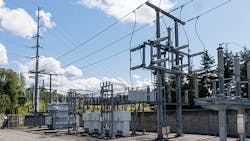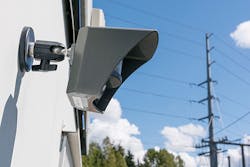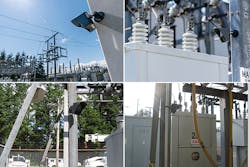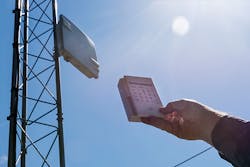Four years ago, Puget Sound Energy (PSE) experienced 117 distribution substation break-ins, costing the Washington utility close to $500,000. While part of this cost included replacing the stolen copper wire, the utility also had to pay for the labor to make the repairs and any associated costs if the substation had to be taken off-line.
After 2011, PSE decided to take a new approach to its copper theft prevention program through deploying a wireless, motion detection camera security system.
Stealing from Substations
During the burglaries, the thieves took anywhere from a few hundred to thousands of dollars worth of copper. To gain entry to the substations, the culprits scaled the razor-topped fence or breached the perimeter fence by cutting through the chain link. In about 98% of the burglary cases, they cut an opening directly through the fence fabric so they could easily enter the substation and exit with the copper wiring.
Before 2011, the substations were particularly attractive targets for thieves because the planning and construction teams staged equipment and materials at the substations. As a result, the thieves would steal entire reels of copper wire. To prevent this from happening, PSE trained its crews to store its valuable materials at service centers equipped with full intrusion-detection security systems, access control and cameras.
After that point, the thieves would break into the substation and steal all of the ground copper wire. If just one person was stealing the copper wire, he or she would stuff as much of the wiring as possible into a backpack before escaping from the substation. If two or more individuals were working together to steal copper wire from the substation, however, they could get away with large amounts of copper.
Many times, the perpetrator would escape from the substations uninjured, but in two different incidents, a suspect made contact with a transformer and sustained severe burns while attempting to steal copper wire.
Attempting to Deter Theft
Back in 2011, the substations that were repeatedly hit were in a “hot zone” located in the Kent Valley area. In this spot, half a dozen distribution substations are in close proximity of each other, and they are also adjacent to a popular bike trail, making it easy for the culprits to escape.
After the thieves hit a substation, PSE would send in its team to make repairs and get the substation back online. Then a few days or weeks later, the substation would be hit again.
To deter the thefts, PSE tried different deterrent techniques. For example, PSE labeled its copper wiring with microdots but discovered this wasn’t a successful approach. For this program to work, a utility can only partner with scrap dealers who have the tools to detect the theft of the wire through the microdot program. For example, credible dealers will fingerprint the seller and record the seller’s driver’s license and vehicle license plate information before finalizing a transaction. While these scrap dealers often are willing to partner with utilities to deter copper theft, thieves do not usually take stolen property to these legitimate businesses; instead, nine out of 10 times, they transport the stolen wiring out of state and try to sell it quickly to a mom-and-pop dealer before being detected.
Since 2011, PSE has replaced all the stolen copper wire with Copperweld. While this product is less expensive and heavier to carry for the culprit, PSE discovered that thieves were still trying to steal it, unaware that it wasn’t copper until they tried to strip and sell it. In these events, PSE still had to cover the cost of the break-in as well as the repair of the equipment.
To deter the thieves, PSE posted signs at its substations stating that the wiring was Copperweld and not copper wire. By taking this approach, however, PSE had to rely on the culprit to read the sign, and often the burglaries occurred under the cover of darkness, and the thieves don’t stop to read the signs. As a result, the Copperweld didn’t serve as a mitigation tool but rather helped PSE to avoid the cost of losing such an expensive asset as copper wire.
Installing Wireless Cameras
To halt the endless substation break-ins, PSE then took another approach. Four years ago, the company partnered with a vendor called Videofied to install wireless video cameras at 140 of its most highly targeted distribution substations.
During the initial install, a contractor secured all the systems. Since then, a service technician on PSE’s corporate security team installs the cameras, which are about the size of a smart phone and are equipped with many different features. For example, they can be attached to any metal object and can blend in with the surroundings within a substation, making them difficult to detect.
Because the cameras are so portable, they can be moved around to where they are needed within PSE’s service territory. Therefore, PSE can deploy and redeploy the systems anytime a substation is targeted for a break-in. Also, the utility can use the systems to monitor the construction of a substation or protect the valuable assets at a job site.
When an individual passes in front of the wireless camera, it activates the system and sends a snapshot to the third-party monitoring center, along with the PSE corporate security team. If the security team determines that the photo is of a person and not of an animal, and there is no work scheduled at the substation, the police are immediately dispatched.
The video cameras can also have an audible alarm attached to them and can light up when someone passes through the area. PSE’s approach is to try to send the thieves to jail. If they activated the audible alarm, then it may scare off the culprits, who would only and come back and try again later.
By installing the cameras, the utility hopes to send the message that anyone who breaks into the substation will get caught and go to jail. The thieves who often commit the copper theft crimes are a small group who share information about which substations to target. Since they’ve learned that if they break into a PSE substation, they will likely go to jail, the number of thefts has plunged.
Case in point: Since deploying the systems in 2011, the utility has had a 94% apprehension rate. The utility relies on the monitoring center to quickly get the information to the police, and for the police to be in the area and be able to provide a quick response. Even so, PSE considers this a good apprehension rate considering the large number of systems deployed.
Training Field Workers
To gain access to the distribution substations, the PSE employees must open a padlock, which has a sign that alerts the individual that a Videofied system is deployed at that substation. The worker will then use a key fob to de-arm the system.
They can then go in, do the work and then rearm it before exiting the substation. If they forget to rearm the system, it will automatically rearm itself within a short time frame. Because the PSE employees recognize that the theft-mitigation measures are making their jobs easier, they have been very cooperative about disarming and rearming the system.
Before deploying the systems, PSE educated its field employees about how it planned to respond to the significant copper theft problem. For example, the security team attended safety and tailgate meetings to educate the workers about the covert monitoring system.
PSE also taught the team to respond even if a person with a hard hat and vest came into the substation. In some cases, the thieves can dress up as substation technicians to try to gain access. For that reason, the dispatchers must not assume that he or she needed to be in the substation if no work was scheduled.
By deploying the Videofied systems, the number of break-ins went from 117 in 2011 to 43 in 2012 to 15 in 2013 and 17 in 2014. So far this year, PSE has had no substation burglaries. To ensure future success with the program, PSE is in the process of building a security command center. By 2016, the utility will have its first fully operational and staffed security command center. Currently, the utility is relying upon various third-party entities to monitor its security systems. One of the third-party monitoring centers is currently monitoring the 108 Videofied systems that are in operation.
While PSE is currently only using the Videofied system primarily at its distribution substations, the utility’s transmission substations have full intrusion detection security systems in place such as access control, intrusion detection and CCTV. Because these substations are more of a critical asset with tie-ins to other utilities, it could cause a significant problem if one went offline. By deterring copper theft at its distribution substations, however, the utility is able to protect people and assets, minimize power interruptions and reduce the late-night calls to technicians to get a substation back on-line.
Dave Foster ([email protected]) is the manager of corporate security for Puget Sound Energy and oversees all of the physical security matters for the company, including critical infrastructure protection, investigations, physical security system design and compliance.
Sidebar: Three Ways Linemen Can Deter Copper Theft
As part of its copper theft prevention program, Puget Sound Energy (PSE) educated its field workforce on how to protect spools of wiring and minimize break-ins. Here are three ways linemen can help a security team in this effort.
1. Secure assets. In some cases, thieves have stolen copper wiring right off of linemen’s trucks. As part of its security awareness campaign, PSE urged employees to park their vehicles in a secure location overnight, such as a service center. Whenever possible, they also should remove any valuable items from their vehicles and store them in a secure location.
2. Help to properly maintain substations. Many distribution substations are located in residential areas, and because they are not very attractive, they are often hidden with vegetation so they can blend into their surroundings. In turn, utilities may unknowingly be providing cover to thieves trying to steal the copper. For that reason, linemen and substation inspectors are encouraged to report any signs of overgrown vegetation. If a thief sees a substation with graffiti and moldy signs falling off a fence, he or she may see that substation as a potential target because it is not being well maintained. By taking care of the appearance of the substation, the field team can make it less of an attractive target.
3. Be alert. Before entering a substation, linemen should perform a visual check, be observant and walk around the perimeter.
By taking extra measures prior to entering, linemen can better ensure their safety.



